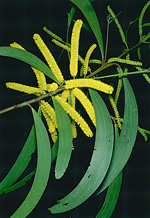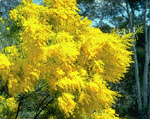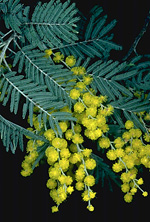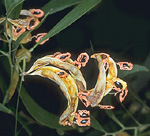 |
This large and distinctive family is distributed throughout the tropics
and subtropics of the world, particularly in semi-arid regions. In Australia,
many genera are found in the rainforests of north-eastern Queensland.
Acacia, the largest genus in Australia, is found wherever trees
or shrubs can grow, and replaces Eucalyptus as the dominant genus
over vast areas of arid and semi-arid woodlands and shrublands.
Characteristic features of the family Mimosaceae in Australia include: - trees, shrubs or lianes, rarely herbaceous
- leaves bipinnate and without a terminal leaflet or (in Australian Acacia only) with the leaf-blade lacking and the petiole flattened into a leaf-like 'phyllode'
- flowers small, several or many aggregated into fluffy heads or elongate spikes with tiny sepals and petals and many long, prominent, white, pink, red or yellow stamens
- fruit a legume (a 2-valved capsule formed from the single carpel, splitting along both sides to release the seeds), or sometimes breaking up transversely into 1-seeded articles
Description
Evergreen trees, or shrubs, or woody or herbaceous vines climbing by tendrils, rarely annual or perennial terrestrial herbs. Tendrils sometimes terminating the leaves. Adult leaves sometimes replaced by phyllodes. Stems unarmed or with thorns or spines arising from the leaf axils; internodes terete, oval or slightly flattened, strongly flattened or distinctly angular. Vegetative reproduction absent or by rhizomes or root suckers. Extra-floral nectaries absent or on the foliage. Internal secretions not obvious or of resin. Plants glabrous, or with simple, dendritic, stellate, clavate, capitate or vesicular glandular or non-glandular, unicellular hairs. Leaves well developed, much reduced (i.e. to scales, etc) or entirely absent (or replaced by phyllodes), alternate and spiral, distichous, or in whorls of 7 or more, cauline if herbs, petiolate, subsessile or sessile; pulvinae present or absent. Stipules distinct and free from the petiole or intrapetiolar, scale-like, membranous, green and leafy, spine-like, bristle-like, rarely gland-like or apparently absent, falling off early or persistent. Lamina simple or bicompound, paripinnate or rarely unifoliolate or bifoliolate, symmetric or conspicuously asymmetric; lamina/leaflets filiform, acicular, subulate, linear, lanceolate, ovate, elliptic, oblanceolate, ovate, oblong, flabellate or orbicular; base cuneate, attenuate, rounded, cordate, lobed or auriculate or oblique; margins entire or crenate, ±flat, revolute or recurved; one-veined, or the venation pinnate, or parallel, with the midrib conspicuous or inconspicuous, and the tertiary venation reticulate or not; surfaces punctate or not punctate; herbaceous, leathery, succulent or hard and spinose; distinctive odour absent, aromatic or foetid. Male and female flowers occurring on the same plant, or bisexual flowers occurring together with only male flowers or both male and female flowers on the same plant, or all the flowers bisexual. Inflorescences terminal, axillary, cauliflorous or ramiflorous, consisting of capitula, glomerules, spikes, racemes, panicles, corymbs or umbels. Bracts and bracteoles present or absent. Pollination by insects or birds. Flowers odourless, fragrant or malodorous, sessile or stalked. Floral disc present or absent; nectaries absent or present on the disc. Perianth regular, of 2 dissimilar whorls or of 1 whorl only, or all whorls ±similar, valvate or open in bud. Calyx segments free or fused, with 4–5 sepals or lobes; calyx cup-shaped, bell-shaped, urn-shaped, funnel-shaped or tubular, herbaceous or papery. Corolla segments free or fused, or some fused, others free, with (0–) 4–5 (–8) petals or lobes, alternating with the sepals or calyx lobes; corolla bell-shaped, urn-shaped, funnel-shaped or tubular, white, cream, yellow, orange, pink, magenta, purple or green, without contrasting markings, membranous or papery; claws absent; lobes ±entire or ciliate or fimbriate. Fertile stamens 4–5, 8, or numerous, opposite to, or not clearly correlated with, the sepals or calyx lobes, free or at least partly fused to the corolla, free of the ovary and style, distinct from each other or fused by their filaments into an open or closed tube, all ±equal. Anthers dorsifixed, versatile, opening inwards by longitudinal slits, 2-celled; appendages absent or apical. Ovary superior and stalked or sessile. Carpel 1; ovary with 1 locule. Style terminal or eccentric, single and unbranched. Ovules 1–numerous, stalked; placentation parietal. Fruit dry dehiscent or indehiscent; a legume, sometimes with explosive dehiscence, or a lomentum; the perianth on the maturing fruit deciduous. Disseminule micro-surface ±smooth, papillate or alveolate, red, brown or black, without contrasting markings, or conspicuously patterned, glossy or dull. Seeds 1–numerous per fruit. Aril present or absent. Cotyledons 2. Embryo straight or curved.
(Note: this description has been generated from the coded data compiled for the key. Any errors in the key data will be reflected in the descriptions.)
A treatment of the family Mimosaceae (excluding Acacia) has been published in:
Flora of Australia 12: 150, and Acacia in Vols 11A: 1-673
and 11B: 1-576.
Australian genera of Mimosaceae (as recognised for the Flora of Australia)
† = some species native, others introduced
* = all species introduced
†Acacia
Adenanthera
Albizia
Archidendron
Archidendropsis
*Calliandra
Cathormion
*Desmanthus
Dichrostachys
Entada
Enterolobium
*Leucaena
Mimosa
Neptunia
Pararchidendron
Paraserianthes
Pithecellobium
*Prosopis
Racosperma
Samanea
Zygia

|
  |

Acacia blakei (flowers)
Photo: M.Fagg © ANBG

Acacia boormannii (flowering plant)
Photo: M.Fagg © ANBG

Acacia dealbata (flowers)
Photo: M.Fagg © ANBG

Acacia melanoxylon (fruits)
Photo: M.Fagg © ANBG

|
 |
|